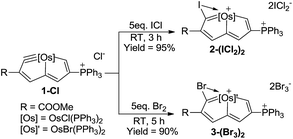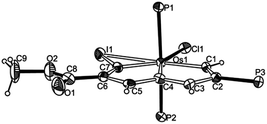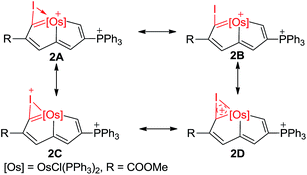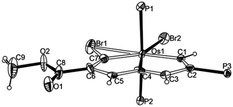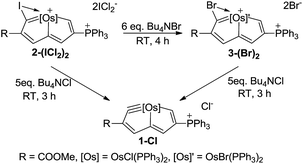 Open Access Article
Open Access ArticleHalogenation of carbyne complexes: isolation of unsaturated metallaiodirenium ion and metallabromirenium ion†
Ming
Luo
,
Congqing
Zhu
,
Lina
Chen
,
Hong
Zhang
* and
Haiping
Xia
*
State Key Laboratory of Physical Chemistry of Solid Surfaces and Collaborative Innovation Center of Chemistry for Energy Materials (iChEM), Department of Chemistry, College of Chemistry and Chemical Engineering, Xiamen University, Xiamen 361005, China. E-mail: zh@xmu.edu.cn; hpxia@xmu.edu.cn
First published on 23rd November 2015
Abstract
The halogenation of metallapentalyne led to the formation of metallapentalenes, which were fully characterized and studied by DFT calculations. The experimental and computational studies indicate that four resonance forms contribute to the overall structure of the metallapentalenes, and one resonance form could be viewed as the first examples of metallaiodirenium and metallabromirenium ions.
The electrophilic addition of halogens is one of the most characteristic reactions of unsaturated hydrocarbons. In organic textbooks the cyclic three-membered halonium ions are postulated as key intermediates to account for the observed stereochemistry in halogenation reactions of alkenes. Strong experimental evidence supporting the mechanism comes from the reactions of hindered alkenes, which can form sufficiently stable halonium ions for characterization by X-ray crystallography.1 In contrast, the nature of the intermediates formed during halogen addition to alkynes is still open to debate. As shown in Scheme 1, cyclic (bridged) cations I and vinyl cations II are generally accepted as key intermediates in the literature.2 We recently isolated the key intermediate of iodine-mediated electrophilic cyclization, an intimate ion-pair that resembles a free vinylic cation.3 In addition, Herges et al. reported that the tribromide adduct intermediate is formed in the addition of bromine to strained alkynes, followed by direct rearrangement to the product (dibromide) without passing through a cationic intermediate.4
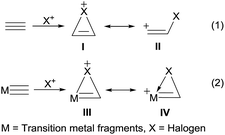 | ||
| Scheme 1 The proposed intermediates of the electrophilic addition reactions of alkynes and metal carbynes with halogens. | ||
Carbyne complexes, i.e. transition metal complexes with metal–carbon triple bonds, can be described as analogs of alkynes wherein a transition metal replaces one of the sp carbons. They have attracted considerable attention because of their remarkable features and their significance as catalysts or reagents for various types of organic transformations.5 The “alkyne-like” character of metal–carbon triple bonds has been demonstrated via the reactions of carbyne complexes with halogens.6 Very recently, we synthesized the first examples of five-membered rings containing metal–carbon triple bonds, namely metallapentalynes.7a These unique carbyne complexes can react with acids, which leads to the formation of metallapentalenes.7b Herein we report the halogenation of a metallapentalyne, from which we isolated the corresponding metallapentalenes, one resonance form of which could be viewed as the first metallaiodirenium and metallabromirenium ions.
The reaction of the metallapentalyne 1-Cl7a with ICl in dichloromethane at room temperature (RT) leads to the formation of the complex 2-(ICl2)2 as an orange solid in excellent yield (Scheme 2). Complex 2-(ICl2)2 was structurally characterized by NMR spectroscopy, elemental analysis, and single-crystal X-ray diffraction.
As shown in Fig. 1, complex 2-(ICl2)2 contains an essentially planar polycyclic metallacycle unit. The mean deviation from the least-squares plane through the nine atoms (Os1, C1–C7, I1) is 0.0068 Å, and the maximum deviation from the least-squares plane through all nine atoms is 0.0135 Å for I1. The C–C bond distances of the osmapentalene ring are in the range of 1.376–1.395 Å, which is within the range observed for other typical metallaaromatics.8 A notable structural feature is the three-membered osmacycle. The I1–C7–Os1 bond angle at the carbene carbon atom is only 94.2°. This is considerably below the smallest value of reported halocarbene complexes8 (the smallest angle is 113.8° in the chlorocarbene complex of chromium,9 to the best of our knowledge), which indicates an interaction between the iodine atom and metal center. The Os1–I1 bond (2.9448 Å) is much longer than the reported longest Os–I sigma bond (2.870 Å),9 suggesting a dative I → Os bond character. In addition, the Os1–C7 bond (1.945 Å) is shorter than the Os1–C1 (2.016 Å) and Os1–C4 (2.133 Å) bonds. The crystallographic data are of sufficient quality to refine the position of the iodine atom, which is found to point towards the resonance form 2A (Scheme 3). DFT calculations further support that resonance form 2A is an important contributor to the overall structure of the cationic complex 2-(ICl2)2. The Wiberg bond indices (bond orders, which are a measure of bond strength) calculated for the bonds within the three-membered osmacycle are 0.52 (Os1–I1), 1.03 (Os1–C7), and 1.06 (I1–C7).10 These values are in agreement with the expected trend in resonance form 2A.
Analogously to the formation of 2-(ICl2)2, we have been able to isolate the corresponding homologous bridged halonium ion 3-(Br3)2 from the electrophilic addition reaction of 1-Cl with excess bromine. As shown in Scheme 2, 1-Cl reacts with Br2 in dichloromethane at RT for five hours resulting in the formation of the three-membered ring. Complex 3-(Br3)2 was isolated as a red solid in 90% yield, and characterized by X-ray diffraction (Fig. 2). The single-crystal X-ray structural analysis demonstrates that the structural features associated with the metallacycle 3-(Br3)2 are quite similar to those found in 2-(ICl2)2. The planarity of 3-(Br3)2 is reflected by the mean deviation (0.0082 Å) from the least-squares plane through the nine atoms (Os1, C1–C7, Br1). The Os–Br bond within the three-membered ring is remarkably longer (2.8254 Å) than the Os1–Br2 bond (2.5268 Å). In a similar fashion to complex 2-(ICl2)2, the Br1–C7–Os1 angle is also small (95.8°). Consistent with the observed bond distances and bond angles, the Wiberg bond indices of the three-membered ring of 3-(Br3)2 were calculated as 0.43 (Os1–Br1), 1.04 (Os1–C7), and 1.10 (Br1–C7).10
Interestingly, the osmapentalene complex is reactive towards nucleophiles. As shown in Scheme 4, the reaction of 2-(ICl2)2 with excess Bu4NBr in dichloromethane at RT for 4 hours affords 3-(Br)2 as a major product. This nucleophilic substitution reaction of 2-(ICl2)2 suggests that the resonance contributor 2B shown in Scheme 3 should be considered in the description of this compound. The formation of 3-(Br)2 would also support resonance forms 2C and 2D where the positive charge is closely associated with C7.
However, the addition of excess Bu4NCl to a dichloromethane solution of 2-(ICl2)2 does not result in the formation of the expected nucleophilic substitution product. Instead, as shown in Scheme 4, the osmapentalyne complex 1-Cl was isolated from the reaction. As suggested by in situ NMR studies, the regeneration of 1-Cl was dependent on the amount of Bu4NCl. When the dichloromethane solution of 2-(ICl2)2 was treated with 5 equivalents of Bu4NCl for 3 hours at RT, complex 1-Cl was regenerated in 95% NMR yield.10 Other ions such as SCN− or I− can also facilitate the transformation to 1. Similarly, the reaction of 3-(Br)2 with 5 equivalents of Bu4NCl produces the osmapentalyne complex 1-Cl. The elimination of the halogen cation from 2-(ICl2)2 or 3-(Br)2 and the regeneration of osmapentalyne 1 by the addition of halides may suggest the contribution of the bridged halonium resonance form 2C (Scheme 3). This corresponds to the natural population analysis11 on the full model of the cations of complexes 2-(ICl2)2 and 3-(Br)2, which demonstrates the charges of I1 and Br1 are +0.674 and +0.462, respectively. Experimentally, the isolation of the analogous metallachlorirenium ion via the reaction of the osmapentalyne complex 1-Cl is not feasible. The addition of Cl2, N-chlorosuccinimide (NCS) or PhICl2 to a dichloromethane solution of 1-Cl at RT only led to a mixture of unidentified species. The failure to obtain the analogous metallachlorirenium ion may stem from the smaller atomic size of the chlorine atom, which would make it harder to sustain the unsaturated three-membered ring. Indeed, the orbital overlap is not perfect in these three-membered ring systems because of the nature of the orbitals, especially for the orbitals of chlorine. The calculated Wiberg bond indices of the three-membered ring of 2-(ICl2)2 and 3-(Br3)2 (0.52 (Os1–I1), 0.43 (Os1–Br1)) also reflect this.
It has long been known that the osmium–carbon triple bond of Os(![[triple bond, length as m-dash]](https://www.rsc.org/images/entities/char_e002.gif) CR)Cl(CO)(PPh3)2 is “acetylene-like”, and thus more likely to react with electrophiles.6 Thus, similarly to the chlorination of alkynes with Cl2, the addition reaction of the carbyne complex Os(
CR)Cl(CO)(PPh3)2 is “acetylene-like”, and thus more likely to react with electrophiles.6 Thus, similarly to the chlorination of alkynes with Cl2, the addition reaction of the carbyne complex Os(![[triple bond, length as m-dash]](https://www.rsc.org/images/entities/char_e002.gif) CR)Cl(CO)(PPh3)2 with Cl2 afforded the osmium chlorocarbene complex Os(
CR)Cl(CO)(PPh3)2 with Cl2 afforded the osmium chlorocarbene complex Os(![[double bond, length as m-dash]](https://www.rsc.org/images/entities/char_e001.gif) CClR)Cl2(CO)(PPh3)2.6b However, the reactions of other carbyne complexes with Br2 or I2 resulted in the preferential formation of the two-electron oxidation products.12 The osmium–carbon triple bond in the six-membered osmabenzynes only forms electrophilic substitution products with Br2.13 To our knowledge, there are as yet no examples of crystallographically well-characterized bromocarbene complexes or iodocarbene complexes.8 We speculate that the nonlinear distortion of the carbyne carbon angle of the osmapentalyne 1-Cl (the computed strain energy of 1-Cl is much larger than that of osmabenzyne7a) facilitates the electrophilic attack of Br2 or I2. The resulting iodocarbene complex 2-(ICl2)2 and bromocarbene complex 3-(Br)2 can be regarded as the first metallaiodirenium ion and metallabromirenium ion, which are similar to the generally proposed intermediates in the halogenation of alkynes.
CClR)Cl2(CO)(PPh3)2.6b However, the reactions of other carbyne complexes with Br2 or I2 resulted in the preferential formation of the two-electron oxidation products.12 The osmium–carbon triple bond in the six-membered osmabenzynes only forms electrophilic substitution products with Br2.13 To our knowledge, there are as yet no examples of crystallographically well-characterized bromocarbene complexes or iodocarbene complexes.8 We speculate that the nonlinear distortion of the carbyne carbon angle of the osmapentalyne 1-Cl (the computed strain energy of 1-Cl is much larger than that of osmabenzyne7a) facilitates the electrophilic attack of Br2 or I2. The resulting iodocarbene complex 2-(ICl2)2 and bromocarbene complex 3-(Br)2 can be regarded as the first metallaiodirenium ion and metallabromirenium ion, which are similar to the generally proposed intermediates in the halogenation of alkynes.
These two bridged halonium ions exhibit remarkably high thermal stability. Complex 2-(ICl2)2 in the solid state can be kept under air for 3 hours at 50 °C. In addition, 3-(Br3)2 is thermally more stable than 2-(ICl2)2 in that the solid sample of 3-(Br3)2 can even persist at 120 °C in air for 3 hours. The notable thermal stability of 2-(ICl2)2 and 3-(Br3)2 may be rationalized by the aromaticity of the metallacycles suggested by the resonance form 2D shown in Scheme 3.
To shed further light on the aromaticity of the complexes, DFT calculations were performed on the simplified unsubstituted model complexes 2′ and 3′, where the PH3 ligands replace the PPh3 ligands.10 The nucleus-independent chemical shift (NICS)14 values were computed for the rings of 2′ and 3′.10 It is widely believed that negative NICS values indicate aromaticity, whereas positive values suggest anti-aromaticity. Consistent with our previously reported aromatic osmapentalene complexes,7 the calculated NICS(1)zz values for the two five-membered rings of 2′ and 3′ are negative (−17.8 and −19.5 ppm for 2′; −17.8 and −19.0 ppm for 3′). The NICS(1)zz values for the three-membered rings of 2′ and 3′ are −9.6 and −8.8 ppm, respectively. These values are comparable to those reported for other metallaaromatics.15 It is worthy mentioning that negative NICS(1) values have been demonstrated to illustrate electron delocalization in the aromatic three-membered ring of chalcogenirenium ions.16
Conclusions
An osmapentalyne with an “alkyne-like” carbyne fragment reacts with halogens to produce osmapentalenes 2-(ICl2)2 and 3-(Br3)2. The experimental and computational studies indicate that four resonance structures contribute to the overall structure of complexes 2-(ICl2)2 and 3-(Br3)2.Acknowledgements
We thank the 973 Program (2012CB821600), the NSFC (No. 21272193, 21332002, and 21490573) and the program for Changjiang Scholars and Innovative Research Team in University.References
- (a) I. Roberts and G. E. Kimball, J. Am. Chem. Soc., 1937, 59, 947 CrossRef CAS; (b) G. A. Olah and J. R. DeMember, J. Am. Chem. Soc., 1970, 92, 718 CrossRef CAS; (c) T. Mori and R. Rathore, Chem. Commun., 1998, 927 RSC; (d) R. S. Brown, R. W. Nagorski, A. J. Bennet, R. E. D. McClung, G. H. M. Aarts, M. Klobukowski, R. McDonald and B. D. Santarsiero, J. Am. Chem. Soc., 1994, 116, 2448 CrossRef CAS.
- (a) D. Lenoir and C. Chiappe, Chem.–Eur. J., 2003, 9, 1037 CrossRef PubMed; (b) T. Okazaki and K. K. Laali, J. Org. Chem., 2006, 71, 9643 CrossRef CAS PubMed; (c) T. Okazaki and K. K. Laali, J. Org. Chem., 2005, 70, 9139 CrossRef CAS PubMed; (d) G. H. Schmid, A. Modro and K. Yates, J. Org. Chem., 1980, 45, 665 CrossRef CAS; (e) M. V. Zabalov, S. S. Karlov, D. A. Lemenovskii and G. S. Zaitseva, J. Org. Chem., 2005, 70, 9175 CrossRef CAS PubMed.
- T. Wang, H. Zhang, F. Han, L. Long, Z. Lin and H. Xia, Angew. Chem., Int. Ed., 2013, 52, 9251 CrossRef CAS PubMed.
- R. Herges, A. Papafilippopoulos, K. Hess, C. Chiappe, D. Lenoir and H. Detert, Angew. Chem., Int. Ed., 2005, 44, 1412 CrossRef CAS PubMed.
- (a) T. Bolaño, M. A. Esteruelas and E. Oñate, J. Organomet. Chem., 2011, 696, 3911 CrossRef; (b) J. W. Herndon, Coord. Chem. Rev., 2012, 256, 1281 CrossRef CAS; (c) G. Jia, Organometallics, 2013, 32, 6852 CrossRef CAS; (d) J. W. Herndon, Coord. Chem. Rev., 2013, 257, 2899 CrossRef CAS; (e) A. Fürstner, Science, 2013, 341, 6152 CrossRef PubMed; (f) C. Shi and G. Jia, Chem. Rev., 2013, 257, 666 CAS; (g) A. Fürstner, Angew. Chem., Int. Ed., 2013, 52, 2794 CrossRef PubMed; (h) J. W. Herndon, Coord. Chem. Rev., 2014, 272, 48 CrossRef CAS; (i) J. W. Herndon, Coord. Chem. Rev., 2015, 286, 30 CrossRef CAS.
- (a) S. Dovesi, E. Solari, R. Scopelliti and C. Floriani, Angew. Chem., Int. Ed., 1999, 38, 2388 CrossRef CAS; (b) G. R. Clark, K. Marsden, W. R. Roper and L. J. Wright, J. Am. Chem. Soc., 1980, 102, 6570 CrossRef CAS; (c) G. R. Clark, C. M. Cochrane, W. R. Roper and L. J. Wight, J. Organomet. Chem., 1980, 199, C35 CrossRef CAS; (d) G. R. Clark, C. M. Cochrane, K. Marsden, W. R. Roper and L. J. Wright, J. Organomet. Chem., 1986, 315, 211 CrossRef CAS; (e) W. R. Roper, J. Organomet. Chem., 1986, 300, 167 CrossRef CAS; (f) L. J. Baker, G. R. Clark, C. E. F. Rickard, W. R. Roper, S. D. Woodgate and L. J. Wright, J. Organomet. Chem., 1998, 551, 247 CrossRef CAS.
- (a) C. Zhu, S. Li, M. Luo, X. Zhou, Y. Niu, M. Lin, J. Zhu, Z. Cao, X. Lu, T. Wen, Z. Xie, P. v. R. Schleyer and H. Xia, Nat. Chem., 2013, 5, 698 CrossRef CAS PubMed; (b) C. Zhu, M. Luo, Q. Zhu, J. Zhu, P. v. R. Schleyer, J. I. C. Wu, X. Lu and H. Xia, Nat. Commun., 2014, 5, 3265 Search PubMed; (c) C. Zhu, Q. Zhu, J. Fan, J. Zhu, X. He, X.-Y. Cao and H. Xia, Angew. Chem., Int. Ed., 2014, 53, 6232 CrossRef CAS PubMed; (d) C. Zhu, X. Zhou, H. Xing, K. An, J. Zhu and H. Xia, Angew. Chem., Int. Ed., 2015, 54, 3102 CrossRef CAS PubMed; (e) C. Zhu, Y. Yang, M. Luo, C. Yang, J. Wu, L. Chen, G. Liu, T. Wen, J. Zhu and H. Xia, Angew. Chem., Int. Ed., 2015, 54, 6181 CrossRef CAS PubMed; (f) C. Zhu, Y. Yang, J. Wu, M. Luo, J. Fan, J. Zhu and H. Xia, Angew. Chem., Int. Ed., 2015, 54, 7189 CrossRef CAS PubMed.
- Based on a search of the Cambridge Structural Database, CSD version 5.35, in February 2015.
- G. Huttner, A. Frank, E. O. Fischer and W. Kleine, J. Organomet. Chem., 1977, 141, C17 CrossRef CAS.
- More detailed results are given in the ESI†.
- A. E. Reed, L. A. Curtiss and F. Weinhold, Chem. Rev., 1988, 88, 899 CrossRef CAS.
- S. R. Caskey, M. H. Stewart, Y. J. Ahn, M. J. A. Johnson, J. L. C. Rowsell and J. W. Kampf, Organometallics, 2007, 26, 1912 CrossRef CAS.
- (a) T. B. Wen, S. M. Ng, W. Y. Hung, Z. Y. Zhou, M. F. Lo, L.-Y. Shek, I. D. Williams, Z. Lin and G. Jia, J. Am. Chem. Soc., 2003, 125, 884 CrossRef CAS PubMed; (b) W. Y. Hung, B. Liu, W. Shou, T. B. Wen, C. Shi, H. H. Y. Sung, I. D. Williams, Z. Lin and G. Jia, J. Am. Chem. Soc., 2011, 133, 18350 CrossRef CAS PubMed.
- (a) P. v. R. Schleyerc, C. Maerker, A. Dransfeld, H. Jiao and N. J. R. v. E. Hommes, J. Am. Chem. Soc., 1996, 118, 6317 CrossRef; (b) Z. Chen, C. S. Wannere, C. Corminboeuf, R. Puchta and P. v. R. Schleyer, Chem. Rev., 2005, 105, 3842 CrossRef CAS PubMed; (c) H. Fallah-Bagher-Shaidaei, C. S. Wannere, C. Corminboeuf, R. Puchta and P. v. R. Schleyer, Org. Lett., 2006, 8, 863 CrossRef CAS PubMed.
- (a) M. A. Iron, A. C. B. Lucassen, H. Cohen, M. E. van der Boom and J. M. L. Martin, J. Am. Chem. Soc., 2004, 126, 11699 CrossRef CAS PubMed; (b) Z. Chen, C. S. Wannere, C. Corminboeuf, R. Puchta and P. v. R. Schleyer, Chem. Rev., 2005, 105, 3842 CrossRef CAS PubMed; (c) G. Periyasamy, N. A. Burton, I. H. Hillier and J. M. H. Thomas, J. Phys. Chem. A, 2008, 112, 5960 CrossRef CAS PubMed; (d) M. Mauksch and S. B. Tsogoeva, Chem. Eur. J., 2010, 16, 7843 CrossRef CAS PubMed; (e) F. Han, T. Wang, J. Li, H. Zhang and H. Xia, Chem. Eur. J., 2014, 20, 4363 CrossRef CAS PubMed.
- (a) H. Poleschner and K. Seppelt, Angew. Chem., Int. Ed., 2008, 47, 6461 CrossRef CAS PubMed; (b) H. Poleschner and K. Seppelt, Angew. Chem., Int. Ed., 2013, 52, 12838 CrossRef CAS PubMed.
Footnote |
| † Electronic supplementary information (ESI) available: characterization details of new compounds, computational details, crystallographic details, NMR spectra. CCDC 1051920(2-(ICl2)2), 1415345(3-(Br3)2). For ESI and crystallographic data in CIF or other electronic format see DOI: 10.1039/c5sc03963k |
| This journal is © The Royal Society of Chemistry 2016 |

